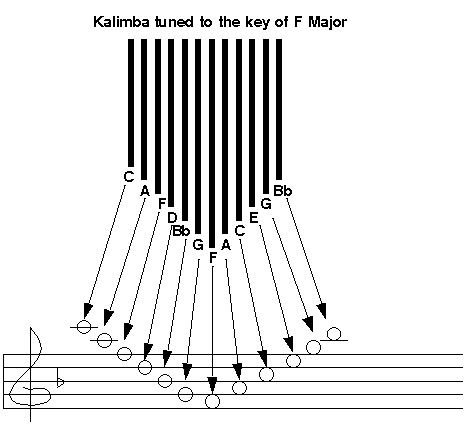
The didjeridu (or "sound stick") is an Australian Aboriginal instrument; it's basically just a long, hollow tube with decorative painings on the outside. Pretty much the most simple instrument you could imagine. You play it by vibrating your lips inside the opening (it's sort of like a big kazoo). The size of the thing gives it a pretty distinctive sound though.
It's usually about 3 to 5 feet long (1 to 1.5 meters), and made from a straight piece of wood (usually eucalyptus), hollowed out by termites, and with the bark stripped. Sometimes you may see ceremonial didjeridus which are as long as 8 feet (2.5 meters). Usually such instruments represent the Rainbow Serpent (one of the Aboriginal Dreamtime Spirits).
Here's a sample of some (non-traditional)
didjeridu music from the group Outback (1,201,081 bytes).
After being kept captive for a few years, they finally managed to escape one day while the giant was out hunting. They quickly made their way back to the hunting grounds of their tribe. Of course, when the giant returned and discovered that his wives were gone he went on a rampage and proceeded to track them back to their tribe.
The elders of the tribe knew that the giant must be on the way, so they set a trap for him. They dug a deep pit and covered it with branches and leaves. When the giant appeared, they used the two sisters to lure the giant into the pit. As soon as he fell in, the warriors of the tribe began to throw spears down on him. As the giant curled up in pain, he began to blow on his penis and out came an amazing sound!
The men of the tribe of course tried to copy this feat, but couldn't get the sound out of themselves. So they went out into the bush and found a eucalyptus tree which had been hollowed out by termites. They cut a large log from the tree and found that by blowing into the log they were able to make the same sound as the giant.
To this day, women are prohibited from looking at a didjeridu by Aboriginal custom.
The didjeridu was originally associated with the North Australian Aboriginal peoples, particularly the Kimberleys in Western Australia, but it has spread to many other tribes.
Playing the instrument is often augmented by banging on the side with clappers, or by slapping boomerangs together. The sticks tap out rhythms while the player blows into the didjeridu. If you've seen didjeridu players before on TV, you were probably looking at corroborees, which is a gathering of Aborigines (often either festive or warlike), usually accompanied by singing, dancing, and sacred rites.
The "trick" with didjeridu playing is that you never stop blowing. You use "circular breathing" to keep a continuous sound going in the instrument. Basically the technique is that you fill your mouth with air, and use your cheeks to push the air out while you take short breaths through your nose. If you're good you can keep it going for a long time without passing out! (I'm not that good...)
Once you've got basic playing down, you can add to it by using techniques similar to bending notes on a harmonica. By changing the shape of the cavity of your mouth you can get a variety of different sounds out of the didjeridu. Good Aboriginal players can mimic animal sounds with the instrument.
The usual position for playing the instrument is sitting, with your left foot extended in front of you, and your right knee raised and bent. The far end of the didjeridu rests on the toes of the left foot.
Kalimbas are usually held cupped in both hands and played with the thumbs. There are two holes on the side which can be covered and uncovered with the index fingers to produce a vibrato effect. The tuning of the instrument can be changed by moving the keys under the bar that hold them in place.
Once there was an old man who had three sons. When they were fully grown, he called them together and told them that since he was so old he could no longer provide for them or himself as he used to. He told them to go out and bring food and clothing to him. The brothers set out on their journey, but when they reached a large river, they decided to follow separate paths and meet back at the river in a year's time.
At the end of the year the three brothers met at the river. The youngest son said that he had nothing but a mirror, but it had a magical power that allowed a person to see things all over the country, no matter how far away they were.
The second brother said he had only a pair of sandals, but that they had a magical power that allowed one to put them on and arrive at any place in the country by taking only one step.
The eldest brother said that he had only one thing, a small kalimba made of calabash. But this kalimba could produce the most beautiful music on earth.
As they began to return home, the youngest brother took out the mirror and looked into it, only to see that their father was dead. They decided to hurry home, so the second brother took out the sandals and lifted the other brothers onto his shoulders. He took a step and at once they were home. As they stood over their dead father, the eldest brother took out his calabash kalimba and began to play a tune. No sooner had he started playing than his father arose as if nothing had been wrong with him. Which brother was wiser?

Basically, you just hold the thing with both hands, put your index fingers over the vibrato holes, and have at it!